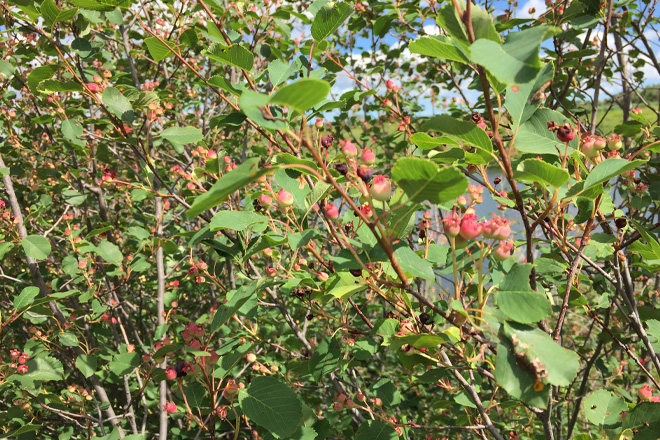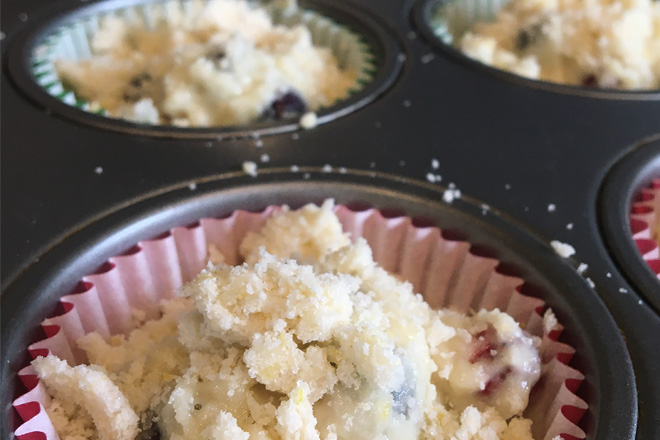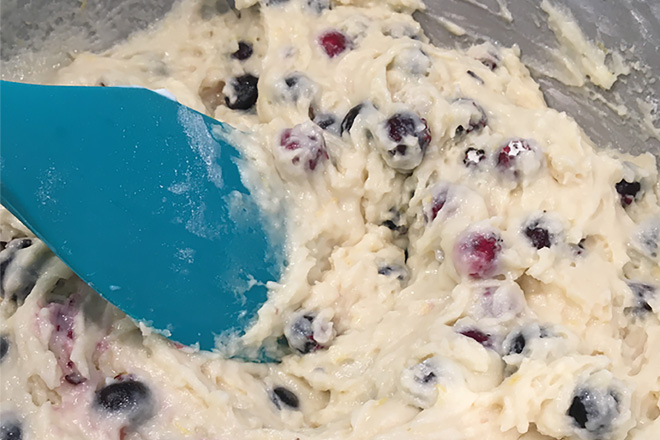The prairie's bounty offers much more than these summertime muffins
By Rachel Bush
July on the northern Great Plain means that Juneberries are ripe, and if you are wild food forager your fingers are stained purple. Depending on where you call home you may not be familiar with Juneberries. You may know them as serviceberry or for our neighbors to the north, Saskatoon berries. Regardless of what you call them,
Amelanchier alnifolia is a seasonal delicacy on the prairie.
I was first exposed to Juneberries while visiting a friend in Manitoba during one of my first summers on the prairie. We met at a small café near Minnedosa, Manitoba, where the Saskatoon Berry Pie was recommended. I obliged, I mean it’s pie after all, even though I had no idea what a Saskatoon berry was.
I was not disappointed. Since that slice of Canadian café pie, the Juneberry has been a sought-after seasonal staple.
The location of a patch of juneberries is a well-guarded secret on par with your favorite morel mushroom spot, one to be cherished, guarded and only shared with the closest of friends. Over the years I’ve been lucky enough to come across a patch here and there on some native prairie hillside or wooded draw while out walking with shotgun and dog in tow seeking out feathered quarry.

That time of year, there are no fruits to be harvested, but knowing how to ID the shrub itself will pay off come summer. Juneberries are a popular species to include in farmstead windbreaks within the plains states, so creating strong landowner relationships, during those October walks can also lead to a sweet summer berry patch.
A few years after that faithful café visit, I was visiting family back in the suburbs of Detroit. While walking around the small yard of my mother-in-law’s condo, where all the trees had all been trimmed to look like lollipops (not exactly a place where you would think to look for wild foods), right there off her deck, tucked into the leaves of a grotesquely manicured shrub, were more ripe juneberries than I could pick.
I ran back into the house as excited as a toddler on Christmas to grab a bowl. I was picking berries! My mother-in-law was not as nearly as impressed at the wild bounty I had just discovered right off of her deck.
With that realization I found myself feeling slightly sad for her and for my nieces that frequently visited her. Here within arm’s reach of where they lay their head, was something I often found myself walking miles to find. Looking back, the sadness I think came from me realizing that something that brought me so much joy could be so disregarded by others. The sadness also came from the realization that the disconnect some people, my own family even, have between the food we eat and where it comes from.
I have a daughter now, and in recent years our family has transitioned to eating primarily wild fish and game and increasingly including other wild foods into our experimental menu. One thing we focus on within our household is understanding not only where your food comes from, but what it means to harvest that food and what it takes to sustain wild populations that allow for our continued harvest. Our daughter has two biologist for parents, so teaching that lesson is second nature and just part of our family dynamic, but it’s still something that needs to be taught.

Some of these lessons come in the field while others come in the kitchen. Outside of nature, the kitchen is the space I feel most at ease in and including my daughter in cooking has been a great adventure. She loves it! We recently had a chance to use some of our foraged juneberries to make an old favorite, lemon juneberry muffins. A great breakfast treat on any July morning, or if you freeze some, a great recipe for a quick breakfast before heading afield on a crisp October morning.
Who knows. Maybe along with your feathered quarry, you’ll happen upon your own Juneberry patch.
Lemon Juneberry Muffins
(or use any wild berries for that matter!)
MUFFINS
2 cups all-purpose flour
½ tsp baking soda
1½ tsp baking powder
¼ tsp salt
2 Tbsp. lemon juice
¾ cup sugar
¼ cup canola oil
1 egg
1 cup plain greek yogurt
2 Tbsp. milk
1½ cup fresh or frozen juneberries (tossed in flour)
Zest of 1 lemon
TOPPING
2Tbsp. sugar
2½ Tbsp. flour
2 Tbsp. butter
1 tsp lemon zest
Course kosher salt
 METHOD
METHOD
Combine flour, baking soda, baking powder and salt in a medium bowl, set aside. In a large mixing bowl, slightly beat egg, oil, sugar, lemon juice, yogurt and milk together. Slowing add dry ingredients to wet, mixing with a spatula. When there is about a ½ cup of flour remaining, add blueberries to flour and toss to coat. Incorporate berries and remaining flour into the mixture.
Use a pastry cutter to blend the topping mixture, minus the salt, together until coarse crumbs form.
Place approximately ¼ cup of muffin batter into a lined muffin pan. Once complete sprinkle topping over muffins, splitting evenly amongst the muffins. Take a pinch of the kosher salt and top each muffin, with a small pinch.
Bake at 400° for 20 minutes. Yields approximately 16 muffins.
Rachel Bush is Pheasants Forever state coordinator in North Dakota.